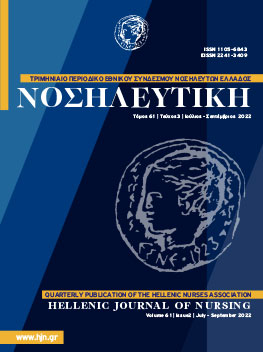The Effect of implementing Infection Control Nursing Interventions in the Frequency of VRE Colonization in Children with Neoplasm
Background: Many attempts have been made in recent years to eradicate hospital infections due to vancomycin-resistant enterococcus (VRE), and to implement nursing interventions in hand hygiene, without adequate evidence of its independent effect. Aim: To investigate the effect of compliance of healthcare professionals with hand hygiene in reducing VRE colonization of children with neoplasm. Method: The compliance with hand hygiene of healthcare professionals was studied in the Haematology-Oncology Paediatric Clinic of Athens University from 1.1.2011 to 30.4.2011. A cross-sectional interventional study applied educational intervention to healthcare professionals and estimated their compliance. Systematic VRE surveillance was conducted in 91 patients, with stool culture before (1st phase) and during the educational intervention (2nd phase). The control group consisted of the VRE(+) patients, who were isolated, and intervention group the VRE(-) patients, for whom nursing educational intervention on hand hygiene was implemented. During the study period, each new VRE (+) and VRE (-) patient admitted was included in the respective control and intervention groups. The Harbarth and Pittet scale of hand hygiene was used for the assessment. The data were analysed with the Statistical Package for Social Sciences (SPSS) v. 15, using t-test, and x² test, and analysis of variance, Anova. Results: The compliance with hand hygiene was studied of all of the nurses (n=17), assistant nurses (n=5) and doctors (n=7), and in total 779 events of hand hygiene were observed. There was a clear increase in the incidence of VRE (+) patients in the control group between the first and the second phase, from 4.9% to 5.7%, while in intervention group the VRE(-) patients increased from 22.1% to 41.8% in the second phase, and no patients in the study changed from VRE(-) to VRE(+), or vice versa. The increase in the average compliance with hand hygiene from the first to the second phase followed the increasing incidence of VRE(-) patients. In the first phase, the compliance of physicians with hand hygiene was 84.4%, of nurses 68.4%, and of nurse assistants 68.5% (p=0.035), while in the second phase there was an observed increase in compliance to 85.4%, 78.9% and 80.4% (p=0.624), respectively. Conclusions: Educational infection control nursing intervention on hand hygiene led to a large increase in the compliance of healthcare professionals with hand hygiene and a significant reduction in VRE colonization.
| Category: | Volume 51, N 4 |
| Hits: | 1359 Hits |
| Created Date: | 15-12-2012 |
| Authors: | Evangelos Dousis , Maria Moschovi , Konstantinos Tsoumakas , Anastasia Pangali , Efrosyni Vlahioti , Agapi Ntoumou , Vasiliki Matziou |
 English
English  Ελληνικά
Ελληνικά 

